Most of us have family commitments and work obligations, leaving a limited time for exercise. Sparing 45-60 minutes for a training session is unimaginable for most people.
Most people exercise to shed excess weight. However, the idea of spending over 15 minutes each day on the treadmill makes them cringe.
Your workouts don’t have to be long and boring. According to a meta-analysis, jumping rope significantly improves cardiovascular fitness, muscular strength, endurance, speed, agility, coordination, and balance. (1)
What else? Jump ropes are super portable and inexpensive, meaning you can use them anywhere and anytime.
I started including a jump rope in my workouts around 2008 when CrossFit started gaining traction. Since then, I have been adding it to my clients’ workouts, and they have been seeing amazing results.
In this article, I will take you over three 15-minute jump rope training sessions that will help you get better weight loss results than treadmill sprints.
Level Up Your Fitness: Join our 💪 strong community in Fitness Volt Newsletter. Get daily inspiration, expert-backed workouts, nutrition tips, the latest in strength sports, and the support you need to reach your goals. Subscribe for free!
Jump Rope: Your Cardio Powerhouse
The treadmill makes your legs work like pistons, and you might feel an intense burn in your quads and calves during endurance runs. However, jumping rope can help improve your cardiovascular health and overall fitness levels in much less time, as it also works your core, shoulders, and arms.
That’s not all. A randomized controlled trial published in the Journal of Sports Medicine and Physical Fitness found that adding a jump rope to a workout regimen significantly improved joint positioning sense (proprioception), coordination, and muscular strength in the lower body. (2)
Here are a few benefits of adding jump rope to your exercise regime:
Coordination and Agility
If you are a UFC or boxing fan, you’ve probably seen your favorite fighter perform an insane number of jump ropes at a crazy pace. Jumping rope is an excellent footwork drill to boost agility, speed, and strength.
Jumping rope is a great cardio training session and works on lower-body strength, says Albert Matheny, R.D., C.S.C.S., co-founder of SoHo Strength Lab, Promix Nutrition, and ARENA.
It requires you to sync your hands and feet and build rhythm and coordination. This will carry over to practically every sport, including tennis, baseball, football, and soccer.
Bone Boost
Jump rope is considered a high-impact sport when done at high intensities. However, contrary to what most people think, this exercise can strengthen your bones. A review published in the Sports Medicine journal showed that jumping exercises (like jump rope) were effective in increasing bone mineral density and reducing osteoporosis with age. (3)
Irvin Sulapas, M.D., assistant professor of sports medicine at the Baylor College of Medicine, weighed in on who should try jumping rope.
“Pretty much anybody can jump rope. However, anyone with ongoing lower body joint issues should avoid doing it at higher intensities.” — Irvin Sulapas
Time (and Money) Saver
Since jump ropes are super compact, you can squeeze a training session into any corner of your day (and home). It saves you time that you would have otherwise spent traveling to a gym. Furthermore, you can carry a jump rope along with you even when you are on the road and want to travel light. It leaves you no excuse for skipping a workout.
A high-quality speed rope costs a fraction of a single month’s gym membership. If you are training at home and are looking for the most affordable training equipment, you cannot go wrong with a jump rope.
Burn Calories
Jump rope workouts involve continuous work at a fast pace, which can beat most traditional cardio workouts. A 30-minute jump rope session can help a 155-pound individual burn around 400-450 calories. To put that into perspective, a treadmill session of the same length and intensity burns approximately 350-400 calories.
Jumping rope is a full-body workout that requires immense hand-eye coordination. The quick arm rotations and jumps will push your cardiovascular system into top gear, helping you melt fat off your body and boost your stamina.
Level Up Your Fitness: Join our 💪 strong community in Fitness Volt Newsletter. Get daily inspiration, expert-backed workouts, nutrition tips, the latest in strength sports, and the support you need to reach your goals. Subscribe for free!
Want to know how many calories you can burn while jumping rope? Check out our convenient calories burned while jumping rope calculator.
Jump Rope: Gear and Technique
Unlike running on a treadmill, jumping rope involves several intricacies, and you must completely nail your technique to get the best bang for your buck while limiting injury risk.
Before we get into the jump rope technique and three killer 15-minute workouts designed to shed the spare tire, here is what you should know about the right gear for this exercise:
- Choosing a Rope: The time of the beaded jump ropes is gone. You should opt for a PVC or wire speed rope. Serious athletes can also opt for a weighted jump rope for better tactical feedback.
- Sizing Matters: Don’t overlook the size of your jump rope. When you stand in the middle of the rope with both feet placed together, the base of the handles should roughly reach your armpits.
- The Right Shoes: Everyone’s feet are different. Consult a fitness professional to find the right shoes for your feet that provide the perfect blend of support and cushioning. The right shoes can reduce the impact on your joints.
Jump Rope Technique
Below is the step-by-step jump rope technique:
- Stand upright with a hip-width stance, your shoulders relaxed, and your core engaged while holding a jump rope’s handles.
- Keep your elbows close to your sides and hold the handles in front of the midline. The rope should be taut and placed against your calves.
- Keeping your elbows pinned, rotate your wrists to swing the rope over your head. Keep the movement small and controlled.
- As the rope is about to touch the floor in front of you, perform a small hop, just enough to clear the rope.
- Work on finding a rhythm and maintaining a consistent jump speed.
Pro Tip: Stay on your toes throughout the exercise. Landing on your heels can increase joint strain. I recommend not wearing earphones while performing this exercise and doing it in front of a mirror.
“Once you’ve mastered the basics, there are always new challenges and ways to get creative,” said Doug Sklar, a certified personal trainer and founder of PhilanthroFIT in New York City.
I added double unders to my exercise regime in 2019. While going from single unders to double unders sounds easy, it requires relearning the fundamentals of jump roping with a completely different technique.
Three 15-Minute Cardio Blast Jump Rope Workouts
Given below are three jump rope workouts suitable for exercisers of different experience levels.
Warm up for the workouts by jogging for a few minutes to get your blood flowing. Also, perform a series of dynamic stretches to loosen up the muscles, joints, tendons, and ligaments.
Beginner Jump Rope Workout
The alternate foot rope jumps can take some time to master. Beginners should stick to the conventional rope jumps for the first four weeks and slowly work the alternate foot jumps into their routine.
| Time | Exercise |
| 00:00-00:30 | Basic Two-Foot Jumps (slow pace) |
| 00:30-01:00 | Rest |
| 01:00-01:30 | Basic Two-Foot Jumps (slightly faster) |
| 01:30-02:00 | Rest |
| 02:00-03:00 | Alternating Foot Jumps |
| 03:00-03:30 | Rest |
| 03:30-04:30 | Basic Two-Foot Jumps (moderate pace) |
| 04:30-05:00 | Rest |
| 05:00-06:00 | Alternating Foot Jumps |
| 06:00-06:30 | Rest |
| 06:30-07:30 | Basic Two-Foot Jumps (slightly faster) |
| 07:30-08:00 | Rest |
| 08:00-09:00 | Single-Leg Hops (30 sec each leg) |
| 09:00-09:30 | Rest |
| 09:30-10:30 | Basic Two-Foot Jumps (moderate pace) |
| 10:30-11:00 | Rest |
| 11:00-12:00 | Basic Two-Foot Jumps (moderate pace) |
| 12:00-12:30 | Rest |
| 12:30-13:30 | Basic Two-Foot Jumps (slightly faster) |
| 13:30-14:00 | Rest |
| 14:00-15:00 | Alternating Foot Jumps |
Feel free to perform the basic jump rope variation if any of the other variations feel too complicated.
Intermediate Jump Rope Workout
In the intermediate workout, you’ll be doing variations like high knees and criss-cross jumps. Spend the time mastering these techniques before you give this workout a try.
| Time | Exercise |
| 00:00-00:30 | Basic Two-Foot Jumps (moderate pace) |
| 00:30-01:00 | Rest |
| 01:00-01:30 | Single-Leg Hops (15 sec each leg) |
| 01:30-02:00 | Rest |
| 02:00-02:30 | High Knees (Running in Place) |
| 02:30-03:00 | Rest |
| 03:00-04:00 | Basic Two-Foot Jumps (fast pace) |
| 04:00-04:30 | Rest |
| 04:30-05:30 | Alternating Foot Jumps |
| 05:30-06:00 | Rest |
| 06:00-07:00 | Basic Two-Foot Jumps (fast pace) |
| 07:00-07:30 | Rest |
| 07:30-08:30 | Criss-Cross Jumps |
| 08:30-09:00 | Rest |
| 09:00-10:00 | High Knees |
| 10:00-10:30 | Rest |
| 10:30-11:30 | Basic Two-Foot Jumps (moderate pace) |
| 11:30-12:00 | Rest |
| 12:00-13:00 | Single-Leg Hops (30 sec each leg) |
| 13:00-13:30 | Rest |
| 13:30-14:30 | Basic Two-Foot Jumps (fast pace) |
| 14:30-15:00 | Rest |
Advanced Jump Rope Workout
The infamous double unders are a part of this workout. I recommend working with a personal trainer to master this technique. Patience and persistence are key here.
| Time | Exercise |
| 00:00-01:00 | Double Unders |
| 01:00-01:30 | Rest |
| 01:30-02:30 | Criss-Cross Jumps |
| 02:30-03:00 | Rest |
| 03:00-04:00 | Boxer Step |
| 04:00-04:30 | Rest |
| 04:30-05:30 | Side-to-Side Jumps |
| 05:30-06:00 | Rest |
| 06:00-07:00 | Double Unders |
| 07:00-07:30 | Rest |
| 07:30-08:30 | High Knees + Butt Kicks |
| 08:30-09:00 | Rest |
| 09:00-10:00 | Sprints (as fast as possible) |
| 10:00-10:30 | Rest |
| 10:30-11:30 | Criss-Cross Jumps |
| 11:30-12:00 | Rest |
| 12:00-13:00 | Side-to-Side Jumps |
| 13:00-13:30 | Rest |
| 13:30-14:30 | Boxer Step |
| 14:30-15:00 | Rest |
Progression and Variation: Level Up Your Jump Rope Workouts
Even if you are a beginner, you will eventually reach a point where even the advanced 15-minute jump rope workouts will become a walk in the park for you.
Here is how to increase the training intensity to ensure consistent progress:
- Go Faster: Are you doing 60 jumps a minute? Aim for 70 in your next workout. Increase the speed until the swings are so fast you cannot see the rope.
- Longer Workouts: Don’t limit yourself to 15-minute workouts. Feel free to perform longer sessions if you have gas left in the tank.
- Use Weights: A weighted rope can completely change the dynamics of your workout. You could also use wrist or ankle weights to add difficulty.
- Try More Complex Skills: Once you’ve mastered the single unders, practice double and triple unders, cross-overs, and squat jumps.
Conclusion
Jump rope is an often-overlooked training tool that can help boost your cardiovascular health and endurance. The best part is that only 15 minutes a day of this super fun exercise can get you to your fitness goals.
Depending on your fitness levels, incorporate one of the three jump rope workouts into your routine.
If you have any questions about jump rope, drop them in the comments below, and I’ll be happy to help!
References
- Zhao, Q., Wang, Y., Niu, Y., & Liu, S. (2023). Jumping Rope Improves the Physical Fitness of Preadolescents Aged 10-12 Years: A Meta-Analysis. Journal of sports science & medicine, 22(2), 367–380.
- Ozer, D., Duzgun, I., Baltaci, G., Karacan, S., & Colakoglu, F. (2011). The effects of rope or weighted rope jump training on strength, coordination, and proprioception in adolescent female volleyball players. The Journal of sports medicine and physical fitness, 51(2), 211–219.
- Zhao, R., Zhao, M., & Zhang, L. (2014). Efficiency of jumping exercise in improving bone mineral density among premenopausal women: a meta-analysis. Sports medicine (Auckland, N.Z.), 44(10), 1393–1402.











